Mulan (1998 film)
8.9 /10 2 Votes
86% Rotten Tomatoes Duration Language English | 7.5/10 IMDb 71% Metacritic Genre Animation, Adventure, Family Country United States | |||||||||||||||||||||||||||||||||
 | ||||||||||||||||||||||||||||||||||
Director Barry CookTony Bancroft Release date June 19, 1998 (1998-06-19) Writer Robert D. San Souci (story), Rita Hsiao (screenplay), Chris Sanders (screenplay), Philip LaZebnik (screenplay), Raymond Singer (screenplay), Eugenia Bostwick-Singer (screenplay), Dean DeBlois (head writer), John Sanford (story), Tim Hodge (story), Burny Mattinson (story), Barry Johnson (story), Ed Gombert (story), Chris Williams (story), Julius Aguimatang (story), Lorna Cook (story), Thom Enriquez (story), Joe Grant (story), Floyd Norman (story), Linda Woolverton (additional story material), Jodi Ann Johnson (additional story material), Alan Ormsby (additional story material), David Reynolds (additional story material), Don Dougherty (additional story material), Jorgen Klubien (additional story material), Denis Rich (additional story material), Joe Ekers (additional story material), Theodore Newton (additional story material), Larry Scholl (additional story material), Daan Jippes (additional story material), Frank Nissen (additional story material), Jeff Snow (additional story material) Film series Walt Disney Animated Classics Songs True To Your Heart (Mulan) Cast (Mulan (voice)), (Mulan (singing voice)), (Grandmother Fa (voice)), (Fa Zhou (voice)), (Fa Li (voice)), (Chi Fu (voice)) Tagline This time, the princess saves the prince. | ||||||||||||||||||||||||||||||||||
Mulan is a 1998 American animated musical action comedy-drama film produced by Walt Disney Feature Animation for Walt Disney Pictures. It is based on the Chinese legend of Hua Mulan, and was Disney's 36th animated feature. It was directed by Tony Bancroft and Barry Cook, with story by Robert D. San Souci and screenplay by Rita Hsiao, Philip LaZebnik, Chris Sanders, Eugenia Bostwick-Singer, and Raymond Singer. Ming-Na, Eddie Murphy, Miguel Ferrer and B. D. Wong star in the English version, while Jackie Chan provided the voice of Captain Li Shang for the Chinese dubs of the film. The film's plot takes place during the Han dynasty, where Fa Mulan, daughter of aged warrior Fa Zhou, impersonates a man to take her father's place during a general conscription to counter a Hun invasion.
Contents
- The best scene in mulan
- Plot
- Cast
- Development
- Writing
- Casting
- Animation and design
- Music
- Release
- Home media
- Box office
- Critical reception
- Accolades
- Reception in China
- Video game
- Live action adaptation
- References in Disney media
- References
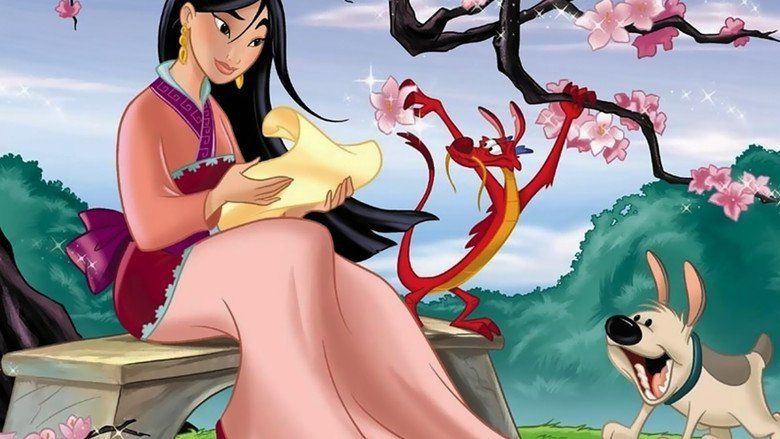
Released during the Disney Renaissance, Mulan was the first of three features produced primarily at the Disney animation studio at Disney-MGM Studios in Orlando, Florida. Development for the film began in 1994, when a number of artistic supervisors were sent to China to receive artistic and cultural inspiration. Mulan was well received by critics and the public, grossing $304 million, earning Golden Globe and Academy Award nominations, and winning several Annie Awards including Best Animated Feature. A 2004 direct-to-video sequel, Mulan II, followed. A live-action adaptation of the film directed by Niki Caro was originally scheduled for November 2, 2018, but was later pushed into a 2019 release in North America.

The best scene in mulan
Plot
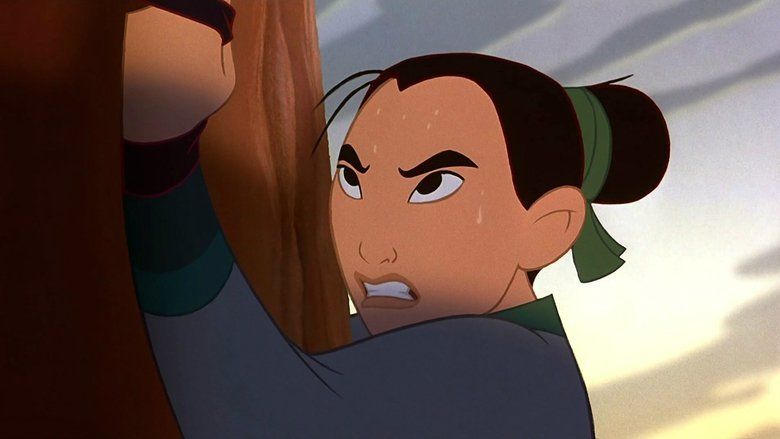
After the Huns, led by the ruthless Shan Yu, invade Han China by breaching the Great Wall, the Chinese emperor orders a general mobilization. Conscription notices require one man from each family to join the Chinese army. When Fa Mulan hears that her elderly father Fa Zhou, the only man in their family and an army veteran, is once more to go to war, she becomes anxious and apprehensive. Taking her father's old armor, she disguises herself as a man, so that she can enlist instead of her parent. The anxious family quickly learn of her departure and Grandmother Fa prays to the family ancestors for Mulan's safety. The ancestors then order their "Great Stone Dragon" to protect Mulan. Mushu, a small dragon, is sent to awaken the Stone Dragon, but accidentally destroys it in the process. Mushu conceals this from the ancestors and resolves to protect Mulan himself.
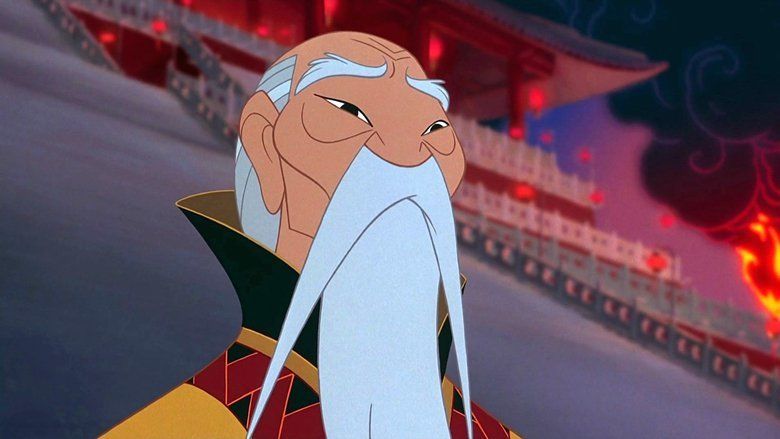
Reporting to the training camp, Mulan is able to pass as a man, although her military skills are initially inexperienced. Mushu provides clumsy guidance to Mulan on how to behave like a man. Under the command of Captain Li Shang, she and her fellow recruits Yao, Ling, and Chien-Po, gradually become trained warriors. Mushu, desiring to see Mulan succeed, creates a fake order from Shang's father, General Li, ordering Shang to follow the main Imperial Army into the mountains. The reinforcements set out, but arrive at a burnt-out encampment and discover that General Li and his troops have been massacred by the Huns. As they solemnly leave the mountains, they are ambushed by the Huns, but Mulan cleverly uses a cannon to summon an avalanche, which buries most of the invaders. An enraged Shan Yu slashes her in the chest, and her deception is revealed when the wound is bandaged. Instead of executing Mulan as the law requires, Shang spares her life, but nonetheless expels her from the army. Mulan is left to follow alone as the recruits depart for the Imperial City to report the news of the Huns' destruction. However, it is revealed that several Hun warriors, including Shan Yu have survived the avalanche, and Mulan catches sight of them as they make their way to the City, intent on capturing the Emperor.
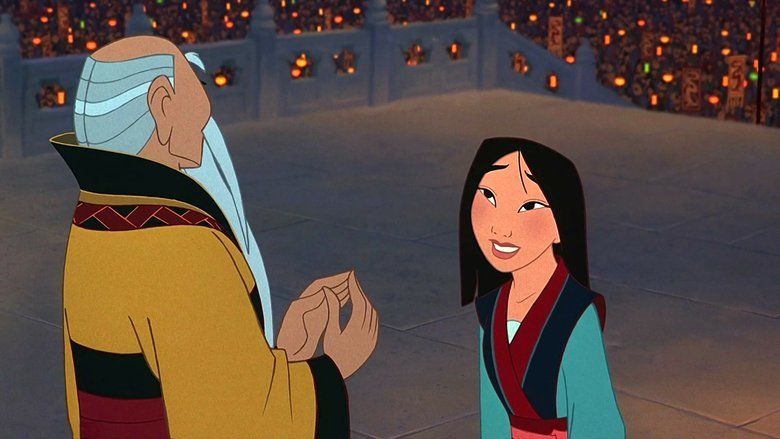
At the Imperial City, Mulan is unable to convince Shang about Shan Yu's intentions. The Huns capture the Emperor, then seize the palace. With Mulan's help, Yao, Ling, and Chien-Po pose as concubines, and are able to enter the palace. With the help of Shang, they defeat Shan Yu's men. As Shang prevents Shan Yu from assassinating the Emperor, Mulan lures the Hun leader onto the roof where she engages him in solo combat. Meanwhile, acting on Mulan's instructions and signal, Mushu fires a bundle of fireworks rockets at Shan Yu. The fireworks strike Shan Yu and kill him. Mulan is praised by the Emperor and the assembled inhabitants of the city, who bow to her in an unprecedented honor. While she accepts the Emperor's crest and Shan Yu's sword as gifts, she politely declines his offer to be his advisor, and asks to return to her family. She returns home and presents these gifts to her father, but he is more overjoyed to have Mulan back safely. Having become enamored with Mulan, Shang soon arrives under the pretext of returning her helmet, but accepts the family's invitation to stay for dinner. Mushu is granted a position as a Fa family guardian by the ancestors amid a returning celebration.
Cast
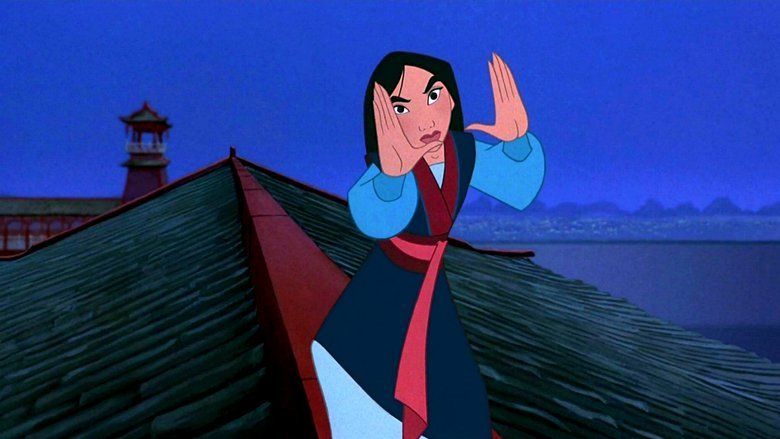
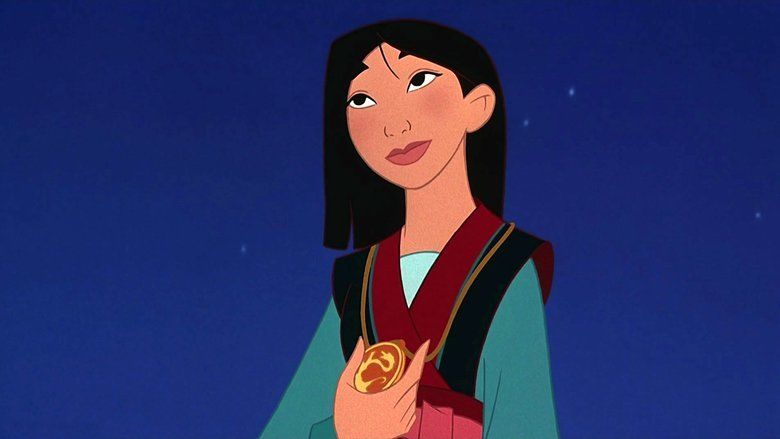
Kelly Chen, Coco Lee and Xu Qing voiced Mulan in the Cantonese, Taiwanese Mandarin and Mainland standard versions of the film respectively, while Jackie Chan provided the voice of Li Shang in all three Chinese versions and appeared in the version of promotional music videos of "I'll Make a Man Out of You".
Development

In 1989, Walt Disney Feature Animation Florida had opened with 40 to 50 employees, with its original purpose to produce cartoon shorts and featurettes. However, by late 1993, following several animation duties on Beauty and the Beast, Aladdin, and The Lion King, Disney executives were convinced to allow the Feature Animation Florida studios to produce their first independent film. Around that same time, Disney Feature Animation developed an interest into Asian-themed legends beginning with the optioning several books by children's book author Robert D. San Souci who had a consulting relationship with Disney executive Jay Dyer. Around that same time, a short straight-to-video film titled "China Doll" about an oppressed and miserable Chinese girl who is whisked away by a British Prince Charming to happiness in the West was in development. Thomas Schumacher asked Souci if he had any additional stories, in which Souci turned in a manuscript of a book based on the Chinese poem "The Song of Fa Mu Lan". Ultimately, Disney decided to combine the two separate projects.
Following the opening of the Feature Animation Florida studios, Barry Cook, who had served as a special-effects animator department since 1982, had directed the Roger Rabbit cartoon Trail Mix-Up produced at the satellite studio. Upon a lunch invitation with Thomas Schumacher, Cook was offered two projects in development: a Scottish folk tale with a dragon or Mulan. Knowledgeable about the existence of dragons in Chinese mythology, Cook suggested adding a dragon to Mulan, in which a week later, Schumacher urged Cook to drop the Scottish project and accept Mulan as his next project. Following this, Cook was immediately assigned as the initial director of the project, and cited influences from Charlie Chaplin and David Lean during production. While working as a supervising animator on the gargoyles on The Hunchback of Notre Dame, Tony Bancroft was offered to co-direct the film following a recommendation from Rob Minkoff, co-director of The Lion King, to Schumacher, in which he accepted, and joined the creative team by early 1995.
Development for Mulan began in 1994, after the production team sent a select group of artistic supervisors to China for three weeks to take photographs and drawings of local landmarks for inspiration; and to soak up local culture. Key members of the creative team at the time – Pam Coats, Barry Cook, Ric Sluiter, Robert Walker, and Mark Henn – were invited to travel to China as a research trip to study the landscape, people, and history of the original legend. From June 17 to July 2, 1994, the research trip flew to Beijing, China, which is where Pam Coats became inspired by the placement of flags on the Great Wall, Datong, Luoyang, Xi'an, Jiayuguan, Dunhuang, and Guilin.
Writing
In its earliest stages, the story was originally conceived as a Tootsie-like romantic comedy film where Mulan, who was a misfit tomboy that loves her father, is betrothed to Shang, whom she has not met. On her betrothal day, her father Fa Zhou carves her destiny on a stone tablet in the family temple, which she shatters in anger, running away to forge her own destiny. In November 1993, Chris Sanders, who had just finished storyboard work on The Lion King, was hoping to work on The Hunchback of Notre Dame until Schumacher appointed him to work on Mulan instead. Acting as Head of Story, Sanders grew frustrated with the romantic comedy aspect of the story, and urged producer Pam Coats to be more faithful to the original legend by having Mulan leave home because of the love for her father. This convinced the filmmakers to decide to change Mulan's character in order to make her more appealing and selfless. Sequence Six – in which Mulan takes her father's conscription order, cuts her long hair, and dons her father's armor – served as a pivotal moment in the evolution of Mulan's character. Director Barry Cook explained that the sequence initially started as a song storyboarded by Barry Johnson and redrawn by character designer Chen-Yi Chang. Following the story changes to have Mulan leave to save her father, the song was dropped. Storyboard artist and co-head of story Dean DeBlois was tasked to revise the sequence, and decided to board the sequence with "minimal dialogue". Assisted with an existing musical selection from another film score courtesy of Sanders, the sequence reel was screened for Peter Schneider and Thomas Schumacher, both of whom were impressed. DeBlois stated, "Sequence Six was the first sequence that got put into production, and it helped to establish our 'silent' approach." Additionally, General Li was not originally going to be related to Shang at all, but by changing the story, the filmmakers were able to mirror the stories of both Shang's and Mulan's love for their fathers.
Because there was no dragon in the original legend, Mulan did not have animal companions; it was Roy E. Disney who suggested the character of Mushu. Veteran story artist Joe Grant created the cricket character, Cri-Kee for, though animator Barry Temple admitted "the directors didn't want him in the movie, the story department didn't want him in the movie. The only people who truly wanted him in the movie were Michael Eisner and Joe Grant – and myself, because I was assigned the character. I would sit in meetings and they’d say, 'Well, where's the cricket during all this?' Somebody else would say, 'Oh, to hell the cricket.' They felt Cri-Kee was a character who wasn't necessary to tell the story, which is true." Throughout development on the film, Grant would slip sketches of Cri-Kee under the directors' door.
Casting
Before production began, the production team sought out Chinese, Japanese, Filipino, or Korean vocal talents. Tia Carrere was an early candidate to voice the title character, and Lea Salonga, who had been the singing voice of Princess Jasmine in Aladdin, was also cast as Mulan's speaking voice, but the directors did not find her attempt at a deeper speaking voice when Mulan impersonated Ping convincing, so Ming-Na Wen was brought in to speak the role. Salonga returned to provide the singing voice. Wen herself landed the role after the filmmakers listened to her narration at the beginning of The Joy Luck Club. Coats reflected on her decision, stating "When we heard Ming-Na doing that voice-over, we knew we had our Mulan. She has a very likable and lovely voice, and those are the qualities we were looking for." For the role of Mushu, Disney was aiming for top Hollywood talent in the vein of Robin Williams's performance as the Genie, and approached Eddie Murphy, who at first balked during recording in the Disney studios, and asked to record the voice in his basement at his Bubble Hill mansion in Englewood, New Jersey. For the speaking voice of Captain Li Shang, B. D. Wong was hired, although his singing voice, for the song "I'll Make a Man Out of You", was performed by Donny Osmond, who had originally auditioned as the speaking voice of the title character in Hercules. Osmond's casting originated from a suggestion from the casting director, and throughout recording, Osmond studied Wong's dialogue tapes, and aimed to match his inflections and personality. Osmond commented that his sons decided that he had finally "made it" in show business when he was in a Disney film. Likewise for the role of Grandmother Fa, June Foray provided for the speaking voice, and Marni Nixon supplied the singing voice.
Animation and design
To achieve a harmonious visual look, producer designer Hans Bacher and art director Ric Sluiter, along with Robert Walker and Head of Backgrounds Robert Stanton collaborated to establish a proper chronological location for the film in Chinese history. Since there was no general consensus on the time of Mulan's existence, they based on the visual design on the Ming and Qing dynasties. An important element of Bacher's design was to turn the art style closer to Chinese painting, with watercolor and simpler design, as opposed to the details of The Lion King and The Hunchback of Notre Dame. Bacher further studied more than thirty-five film directors ranging from the silent era German Expressionism, British and American epics of the 1950s and 60s, and the spaghetti westerns for inspiration for composition, lighting, and staging that would establish settings that enhanced the characters, and additional inspiration was found in the earlier Disney animated films such as Bambi, Pinocchio, and Dumbo to establish a sense of staging.
In October 1997, the Walt Disney Company announced a major expansion of its Florida animation operations constructing a 200,000-square-foot, four-story animation building and the addition of 400 animators to the workforce.
To create 2,000 Hun soldiers during the Huns' attack sequence, the production team developed crowd simulation software called Attila. This software allows thousands of unique characters to move autonomously. A variant of the program called Dynasty was used in the final battle sequence to create a crowd of 3,000 in the Forbidden City. Pixar's photorealistic open API RenderMan was used to render the crowd. Another software developed for this movie was Faux Plane, which was used to add depth to flat two-dimensional painting. Although developed late in production progress, Faux Plane was used in five shots, including the dramatic sequence which features the Great Wall of China, and the final battle sequence when Mulan runs to the Forbidden City. During the scene in which the Chinese are bowing to Mulan, the crowd is a panoramic film of real people bowing. It was edited into the animated foreground of the scene.
Music
In March 1994, Stephen Schwartz was attached to compose the lyrics and music for the songs for the film. Following the research trip to China in June 1994, Schwartz was contacted by former Disney studio chairman Jeffrey Katzenberg to compose songs for The Prince of Egypt, which he agreed. Peter Schneider, then-president of Walt Disney Feature Animation, threatened to have Schwartz's name removed from any publicity materials for Pocahontas and The Hunchback of Notre Dame. Michael Eisner phoned Schwartz, and urged him to back out of his commitment to DreamWorks which he refused and left the project. After Schwartz's departure, his three songs, "Written in Stone", "Destiny", and "China Doll", were dropped amid story and character changes by 1995. Shortly after, Disney music executive Chris Montan heard Matthew Wilder's demo for a stage musical adaption of Anne Rice's Cry to Heaven, and selected Wilder to replace Schwartz. David Zippel then joined to write the lyrics. The film featured five songs composed by Wilder and Zippel, with a sixth originally planned for Mushu, but dropped following Eddie Murphy's involvement with the character.
Although Danny Elfman and Thomas Newman were considered to score the film, English composer Rachel Portman was selected as the film composer. However, Portman became pregnant during production, and decided to back out. Following Portman's departure, Randy Edelman—whose Dragonheart theme was used in the trailer—and Kitarō were considered, until Jerry Goldsmith became available and signed on after dropping out of a project. The film's soundtrack is credited for starting the career of pop singer Christina Aguilera, whose first song to be released in the U.S. was her rendition of "Reflection," the first single from the Mulan soundtrack. The song, and Aguilera's vocals, were so well received that it landed her a recording contract with RCA records. In 1999, she would go on to release her self-titled debut album, on which Reflection was also included. The pop version of Reflection has a Polish version ("Lustro" performed by Edyta Górniak) and 2 Spanish versions, for Spain (performed by Malú) and Latin America (performed by Lucero). Other international versions include a Brazilian Portuguese version by Sandy & Junior ("Imagem"), a Korean version performed by Lena Park, and a Mandarin version by Coco Lee.
The music featured during the haircut scene, often referred as the Mulan Decision score, is different in the soundtrack album. The soundtrack album uses an orchestrated score while the movie uses heavy synthesizer music. The synthesizer version is available on the limited edition CD. Salonga, who often sings movie music in her concerts, has done a Disney medley which climaxes with an expanded version of "Reflection" (not the same as those in Aguilera's version). Salonga also provided the singing voice for Mulan in the movie's sequel, Mulan II.
Release
Because of the disappointing box office performances of The Hunchback of Notre Dame and Hercules, Disney restricted its marketing campaign for Mulan spending $30 million on promotional advertisements compared to more than $60 million for Hercules the year before. Instead of the lavish media event premieres of Pocahontas in Central Park and the electric light parade on Fifth Avenue for Hercules, Disney opted to premiere the film at the Hollywood Bowl complete with Chinese lanterns and fortune cookies. Two days before the general release, McDonald's launched its promotional campaign by including one of eight toys free with the purchase of a Happy Meal. In collaboration with Disney, Hyperion Books published The Art of Mulan authored by Jeff Kurtti, which chronicled the production of the film. In addition with its publication, Hyperion Books also issued a collector's "folding, accordion book" of the ancient poem that inspired the film. On August 18, 1998, around 3,700 backpacks and 1,800 pieces of luggage were recalled back to their manufacture, Pyramid Accessories Inc., when it is discovered they contained lead-based paint.
Home media
The film was first released on VHS on February 2, 1999 as part of the Walt Disney Masterpiece Collection line. That year, the film was released on DVD as part of the Limited Issues line. In 2000, it was released on DVD as part of the Walt Disney Gold Classic Collection line. The second DVD release entered moratorium on January 31, 2002. On October 26, 2004, Walt Disney Home Entertainment released Mulan on DVD as a 2-disc Special Edition.
In March 2013, Walt Disney Studios Home Entertainment released Mulan and Mulan II on Blu-ray and DVD to coincide with the film's 15th anniversary.
Box office
Mulan's opening weekend box office gross revenues were $22.8 million, making it the second-highest grossing movie that week, behind only The X-Files. It went on to gross $120 million in the U.S. and Canada combined, and $304 million worldwide, making it the second-highest grossing family film of the year, behind A Bug's Life, and the seventh-highest grossing film of the year overall. While Mulan domestically outgrossed the two Disney films which had preceded it, The Hunchback of Notre Dame and Hercules, its box office returns failed to match those of the Disney films of the early 1990s such as Beauty and the Beast, Aladdin, and The Lion King. Internationally, its highest grossing releases included those in the United Kingdom ($14.6 million) and France ($10.2 million).
Critical reception
Reception of Mulan was mostly positive. Rotten Tomatoes gives it a rating of 86%, based on 73 reviews, with an average rating of 7.5/10. The site's consensus reads, "Exploring themes of family duty and honor, Mulan breaks new ground as a Disney film, while still bringing vibrant animation and sprightly characters to the screen." In a 2009 countdown, Rotten Tomatoes ranked it twenty-fourth out of the fifty canonical animated Disney features. On Metacritic, the film has a score of 71 out of 100, based on 24 critics, indicating "generally favorable reviews". CinemaScore reported that audiences gave the film a rare "A+" grade.
Kyle Suggs described the visuals as "breathtaking," and Dan Jardine described them as "magnificently animated." Film critic Roger Ebert gave Mulan three and a half stars out of four in his written review. He said that "Mulan is an impressive achievement, with a story and treatment ranking with Beauty and the Beast and The Lion King". Negative reviews described it as a "disappointment". The songs were accused of not being memorable, and slowing down the pace of the movie. Ed Gonzalez of Slant Magazine criticized the film as "soulless" in its portrayal of Asian society.
This movie was also the subject of comment from feminist critics. Mimi Nguyen says the film "pokes fun at the ultimately repressive gender roles that seek to make Mulan a domesticated creature". Nadya Labi agreed, saying "there is a lyric in the film that gives the lie to the bravado of the entire girl-power movement." She pointed out that Mulan needed to become a boy in order to accomplish what she did. Kathleen Karlyn, an assistant professor of English at the University of Oregon, also criticized the film's portrayal of gender roles: "In order to even imagine female heroism, we're placing it in the realm of fantasy". Pam Coats, the producer of Mulan, said that the film aims to present a character who exhibits both masculine and feminine influences, being both physically and mentally strong.
Accolades
Mulan won several Annie Awards, including Best Animated Feature and Individual achievement awards to Pam Coats for producing; Barry Cook and Tony Bancroft for directing; Rita Hsiao, Christopher Sanders, Phillip LaZebnick, Raymond Singer and Eugenia Bostwick-Singer for writing, Chris Sanders for storyboarding, Hans Bacher for production design, David Tidgwell for effects animation, Ming-Na for voice acting for the character of Mulan, Ruben A. Aquino for character animation, and Matthew Wilder, David Zippel and Jerry Goldsmith for music. (Tom Bancroft and Mark Henn were also nominated for an Annie Award for Character Animation.) The musical score also received significant praise. Jerry Goldsmith won the 1999 BMI Film Music Award. Goldsmith was nominated for the Academy Award for Best Original Music Score, but lost to Stephen Warbeck's score for Shakespeare in Love. Goldsmith was nominated for the Golden Globe Award for Best Original Score. Matthew Wilder and David Zippel were nominated for a Golden Globe Award for Best Original Song for "Reflection". They were beaten by The Truman Show and "The Prayer" from Quest for Camelot, respectively.
The film is recognized by American Film Institute in these lists:
Reception in China
Disney was keen to promote Mulan to the Chinese, hoping to replicate their success with the 1994 film The Lion King, which was one of the country's highest-grossing Western films at that time. Disney also hoped it might smooth over relations with the Chinese government which had soured after the release of Kundun, a Disney-funded biography of the Dalai Lama that the Chinese government considered politically provocative. China had threatened to curtail business negotiations with Disney over that film and, as the government only accepts ten Western films per year to be shown in their country, Mulan's chances of being accepted were low. Finally, after a year's delay, the Chinese government did allow the film a limited Chinese release, but only after the Chinese New Year, so as to ensure that local films dominated the more lucrative holiday market. Box office income was low, due to both the unfavorable release date and rampant piracy. Chinese people also complained about Mulan's depiction as too foreign-looking and the story as too different from the myths.
Video game
A PlayStation action-adventure game based on the film, titled Disney's Story Studio: Mulan, published by Ubisoft and developed by Revolution Software (under the name "Kids Revolution"), was released on December 15, 1999. The game was met with generally positive reception and holds a 70.67% average rating at the review aggregator website GameRankings.
Live-action adaptation
Walt Disney Pictures first expressed interest in a live-action adaptation of Mulan in the 2000s. Zhang Ziyi was to star in it and Chuck Russell was chosen as the director. The film was originally planned to start filming in October 2010, but was eventually canceled.
In 2015, Disney again began developing a live-action remake. Elizabeth Martin and Lauren Hynek's script treatment reportedly featured a white merchant who falls in love with Mulan, and is drawn into a central role in the country's conflict with the Huns. According to a Vanity Fair source, the spec script was only a "jumping-off point" and all main characters will in fact be Chinese. Dawn of the Planet of the Apes and Jurassic World screenwriters Rick Jaffa and Amanda Silver are to rewrite Hynek and Martin's screenplay with Chris Bender, J. C. Spink and Jason Reed producing. In February 2017, it was announced that Niki Caro will direct the live-action adaptation of the 1998 animated film and will be the second woman at the studio to direct a movie budgeted at over $100 million, after Ava DuVernay.
The casting process of a Chinese actress to portray the heroine began in October 2016. The film was originally scheduled to be released on November 2, 2018 but was pushed into a 2019 release instead.
References in Disney media
Although she is royalty neither by birth nor marriage (her husband is merely a high-ranking military officer), Mulan is part of the Disney Princess media franchise. In the film Lilo & Stitch, Nani has a poster of Mulan in her room. Mulan is also present in the Disney and Square Enix video game series Kingdom Hearts. In the first Kingdom Hearts and in Kingdom Hearts: Chain of Memories, Mushu is a summonable character, and in Kingdom Hearts II, the movie is featured as a playable world named "The Land of Dragons", with the plot being changed to accommodate the game's characters (Sora, Donald and Goofy) and Mulan (both as herself and as "Ping") able to join the player's party as a skilled sword fighter. Actress Jamie Chung plays a live-action version of Mulan in the second, third, and fifth seasons of the ABC television series Once Upon a Time.
References
Mulan (1998 film) WikipediaMulan (1998 film) IMDbMulan (1998 film) Rotten TomatoesMulan (1998 film) MetacriticMulan (1998 film) themoviedb.org
